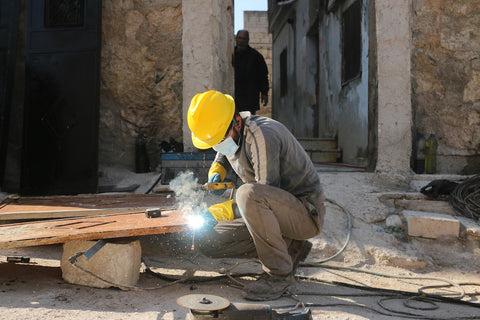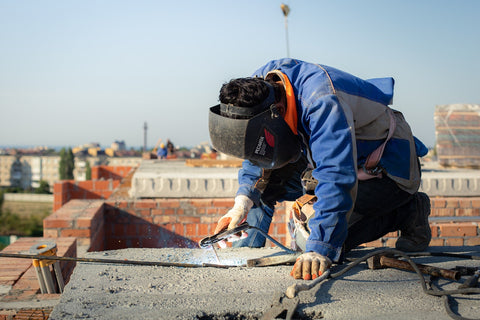Welding is crucial in the construction industry, serving as a critical fabrication process in creating robust and secure structures. This process involves the fusion of materials, typically metals or thermoplastics, by utilizing high heat to melt the parts together. In the sphere of construction, welding finds its application in various tasks: from joining steel frames that form the skeleton of buildings to producing machinery and equipment essential for construction tasks.
Materials, cost, efficiency, and safety are determining factors when choosing a welding method in the construction sector. Processes like shielded metal arc welding (AKA, stick welding), gas tungsten arc welding (GTAW), and flux-cored arc welding (FCAW) are commonly used. Each method brings distinctive benefits, and the selection depends mostly on the specific requirements of the project.
Quality welding is integral to the structural integrity and longevity of constructed buildings and infrastructure. It ensures safety and durability, resisting environmental stressors and bearing the structure's weight. Therefore, the construction industry relies heavily on skilled welders and quality welding equipment, emphasizing their pivotal role in shaping the built environment.
What do construction welders do?

Construction welders play a critical role in the building industry, with their most important job being joining metal pieces. This task requires a high degree of skill and precision, as the stability and durability of the structures they work on hinge significantly on the quality of their work.
Welding in construction involves using specialized tools to create intense heat that melts metal at specific points, allowing for the joining of separate pieces into a unified whole. This process is called fusion, and it requires the welder to be adept at controlling the heat and understanding how to adjust it based on the thickness and metal type.
In construction, this is particularly important when constructing buildings, bridges, pipelines, and other critical infrastructural components. The strength and stability of these structures depend primarily on the welder's skill and precision, since a poorly executed weld could weaken the entire structure, leading to catastrophic failure under stress.
Moreover, construction welders need to be knowledgeable about different welding techniques, such as shielded metal arc welding (SMAW), gas metal arc welding (GMAW), and flux-cored arc welding (FCAW). Each of these methods has unique benefits and considerations, and the choice of technique can significantly impact the quality of the weld.
In addition, they also need to be well-versed in interpreting blueprints and understanding the specific requirements for each job, including knowing where to place welds, the type of weld required, and how to prepare the metal for welding.
To sum up, construction welders are crucial to joining metal pieces together. Welding requires technical skills in handling specific welding equipment and methods and a thorough understanding of the construction design and safety requirements. It is a job that demands precision, diligence and a constant focus on quality and safety.
What does a day in the life of a construction welder look like?

Welding involves using heat to melt and join pieces of metal together. One of the most common tasks for a construction welder is arc welding, which uses an electric current to create enough heat to meld metals. This method is often employed in commercial construction for its strength and durability.
Another task might be MIG welding, which stands for metal inert gas welding. This type of welder uses a gun that feeds wire at an adjustable speed and flows an inert gas over the weld to shield it from contaminants in the environment. MIG works well for thinner and lighter metals.
Tungsten inert gas welding (TIG) is another technique a construction welder might need to know. This process uses a non-consumable tungsten electrode, which delivers the current to the welding arc. The tungsten and weld puddle are protected and cooled with an inert gas, typically argon. Welders often choose TIG welding for stainless steel and aluminum structures.
Moreover, a construction welder could engage in the fitting process, which involves laying out, positioning, aligning, and securing parts before assembly. Construction fitters set the foundation for the rest of the welding process.
On a larger scale, construction welders may be integral in fabricating major steel structures, requiring exceptional welding skills and a high level of technical knowledge and understanding of structural engineering principles.
Inspecting completed welds to ensure their structural integrity is another critical task involving looking for potential welding issues, such as cracks or deformities, which could compromise the weld's strength and the overall safety of the structure.
Finally, a construction welder must carry out routine maintenance tasks, including safety checks on equipment, cleaning tools and the work area, calibrating welding tools, and replacing damaged equipment as necessary.
Each of these tasks plays an essential role in the overall construction process. A skilled construction welder is adept at various welding techniques and has a strong understanding of the construction industry and safety regulations. This wide range of responsibilities makes them a fundamental part of any construction team.
What is a construction welder salary?

As labor market conditions continue to evolve, understanding the earning potential of various occupations is critical. One such profession, construction welding, enjoys a wide range of earnings depending on multiple factors such as location, experience, and specialization.
According to data from the Bureau of Labor Statistics in the United States, the median annual wage for welders, cutters, solderers, and brazers, including construction welders, was $44,190 in 2020, meaning that half of the welders earned more than this amount and half earned less. The lowest 10 percent earned less than $32,590, and the highest 10 percent earned more than $64,240.
Earnings can vary significantly by location. Welders in states with heavy industrial and construction activities, like Alaska or North Dakota, often earn more than their counterparts in other states. Similarly, welders in metropolitan areas may make more due to these regions' higher cost of living.
Furthermore, experience and specialization can also affect a welder's earnings. As with many professions, more experienced welders tend to command higher salaries, and those with specialized skills, such as underwater welding or pipeline welding, can expect significantly higher pay due to the complexity and risk associated with these roles. Ultimately, welding jobs in construction can be lucrative, but the exact earnings will depend on various factors.
What training and education do construction welders need?

The first step to becoming a construction welder involves acquiring a high school diploma or equivalent. High school mathematics, physics, and industrial arts courses can provide the foundation for understanding the technical aspects of welding. Additionally, high school vocational-technical programs offer the chance to learn welding basics through classroom theory and hands-on practice.
After high school, individuals often pursue formal training through programs offered in colleges, technical schools, and vocational institutions. These programs, which can last six months to two years, cover various welding methods, safety procedures, blueprint reading, and metallurgy. Typically, completing such programs results in a diploma, certificate, or associate degree in welding technology.
Aside from formal education, apprenticeships provide an excellent route to gaining practical, hands-on experience in construction welding. Apprenticeships typically last three to five years and involve supervised, on-the-job training supplemented by classroom instruction. After completion, apprentices can gain welding certifications from organizations like the American Welding Society, which are highly beneficial in advancement within the industry.
In summary
Construction welding is a fundamental process in the building sector, providing structural strength and stability. This article delves into the intricate details of construction welding, highlighting different welding techniques such as arc, MIG, and TIG welding. Each method exhibits unique advantages depending on the project requirements, outlining the need for a careful selection process.
Quality and safety are paramount in this field, necessitating strict adherence to welding codes established by the American Welding Society. This piece further explores modern advancements in welding technology, such as automation, that enhance efficiency and precision while minimizing the risks associated with manual welding. It underscores the importance of skilled welders with the technical knowledge and practical abilities to deliver robust, high-quality construction welds.

Leave a comment 0 comments, be the first!